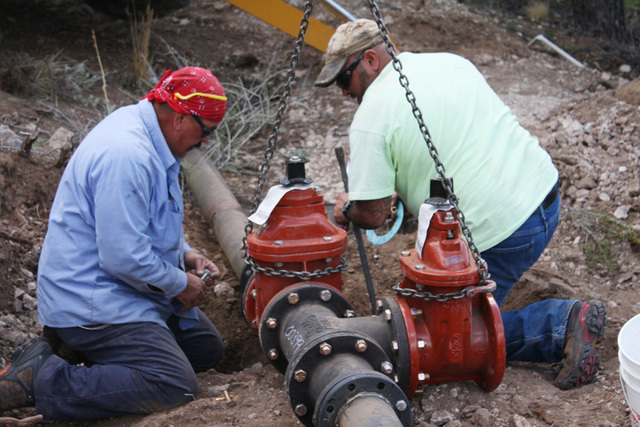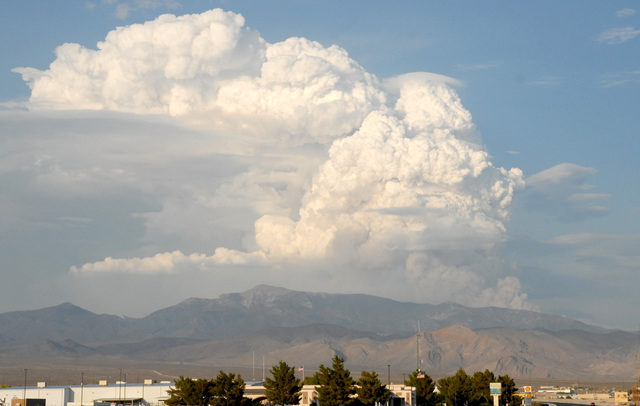Board hears bold idea in Trout Canyon fix
The Nye County Water District Governing Board heard a bold idea Monday that could accomplish a number of strategic goals, including providing a permanent water system to nearby Trout Canyon.
The Carpenter 1 Fire and subsequent flooding last year demolished the 50-year-old pipeline that delivered potable water to the hand full of residents with homes in Trout Canyon. Ever since, those residents have had to haul their own potable water from a neighbor’s well into their homes.
Six weeks ago, a nonprofit, the Trout Canyon Land and Water Users Association, was formed to find solutions to the ongoing water woes. At some point, the association’s president, Bob McCormick, got together with water board Chair Donna Lamm, Valley Electric Association officials and county staff members to come up with an idea that could benefit all involved.
So far, the idea that’s taken shape includes building a new pipeline accessing the Trout Canyon springs, delivering water to the canyon’s beleaguered residents, diverting a majority into a hydroelectric generation station, benefiting VEA’s grid, and then shipping water into Pahrump Valley’s groundwater basin, to the tune of about 4,000 acre feet a year or more.
“The Division of Water Resources is on board with the concept because it brings water that is currently not being utilized into the south-end of the basin. I certainly won’t speak for them, the initial discussion seemed favorable,” county staff member Levi Kryder told water board members. “We are at the very earliest stages of this project. And it’s a bit of a misnomer to call it a project yet. It’s really an idea we are exploring to see if we can turn it into a project.”
McCormick told the board that he is attempting to explore as many opportunities as possible to return reliable water service to Trout Canyon and that this idea seems to suit the most local interests at one time.
“What we have, as Levi has laid out, is a concept, the possibility of a plan, interesting not only for Trout Canyon, but for the whole basin. We feel this is a great opportunity to come together, not only as three different entities, but as a region to utilize water that otherwise would not be used. The permitted water there is already quite high, but there is an additional quantity of water,” he said. “There is a quite a lot of water there that is far beyond what the Trout Canyon community would use. I think that is the big attraction for all the parties involved, to tap into water that is not currently being used in a very beneficial way for all parties.”
The Trout Canyon springs originate about three miles from the community and sits on Forest Service land in Clark County. However, the water is part of Basin 162, which is Pahrump Valley’s designated groundwater aquifer. Two existing permits, one an allotment for more than 100 acre feet and the other an allotment for power generation at six cubic feet of water per second, are in place at the water source. Those could be expanded.
Also, a permanent easement crosses the Forest Service property near the springs, which would make future development of this untapped resource easier, officials said.
McCormick said his association is looking to access U.S. Department of Agriculture funds, now that it is an official nonprofit. He said in order to access available grant monies, his group will need to perform two major tasks, an engineering report and an environment assessment. The group has already contracted with Sunrise Engineering of Utah to perform an engineering study at a cost of about $30,000. The association needs an additional $43,000 for an environmental assessment.
McCormick said the total cost of building a modern water system for Trout Canyon would likely be about $3 million by itself. He said VEA’s participation could shoulder some of the financial burden, however, should it decide to build a generation station and pipeline further south of the canyon, closer to Pahrump. Then he said it would be up to Nye County to connect to the pipeline there. Federal grant money could defray much of these costs, too.
“If a pipeline was built to the community, the excess water in the pipeline, once the community is supplied, could be used to generate hydroelectric power, which could be fed into the VEA grid and then the excess water from that could be piped down to the basin floor or south end of the Pahrump basin and reinjected for aquifer storage and recovery or put directly into a utility or question mark,” Kryder said, alluding to any number of possibilities on the horizon.
A discussion later Monday at the Basin 162 Groundwater Management Plan Advisory Committee meeting suggested that a cost-benefit analysis must still be completed before moving forward with any pipeline from Trout Canyon to Pahrump. Contract county staff member Oz Wichman told the committee that the costs of any pipeline would likely hover around $5 per diameter inch per foot of piping, or about $60 for every foot of 12-inch pipe. At 17 miles of pipeline, costs could easily exceed $5.3 million.
“As far as the potential benefits to the Pahrump community go, when I first looked at this, I thought, well, maybe this could be incorporated into the groundwater management plan that is going to be developed for Pahrump. As some sort of alternative, maybe this could result in a project that brings water for use in the Pahrump Valley that physically doesn’t come here right now,” Kryder said.
Water importation, basin committee members agreed, was a subject that deserved close scrutiny in the future.
What remains unclear is how Clark County and Southern Nevada Water Authority officials may react to the idea, since that county has its own water issues with which to deal. McCormick assured water board members that Clark County officials have been invited to provide their own input.
Look for more information about Monday’s water board meeting in Friday’s Pahrump Valley Times.


















